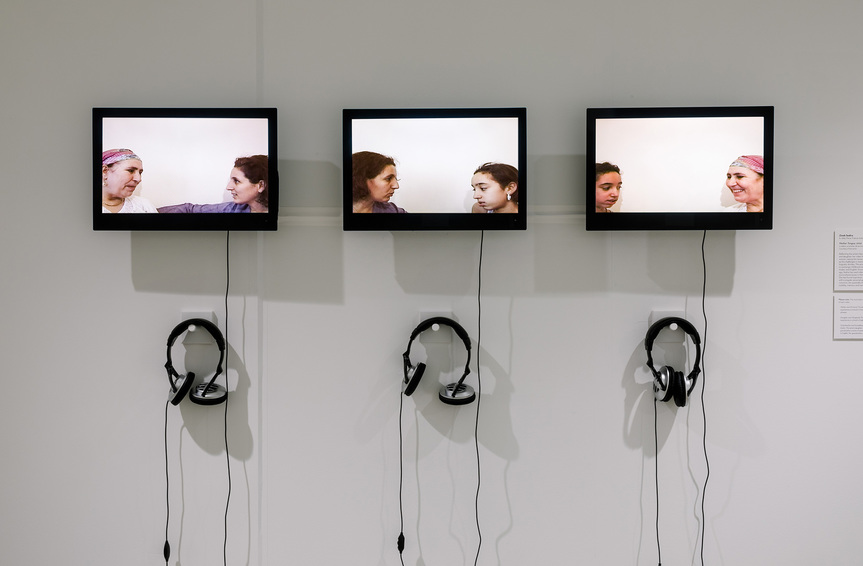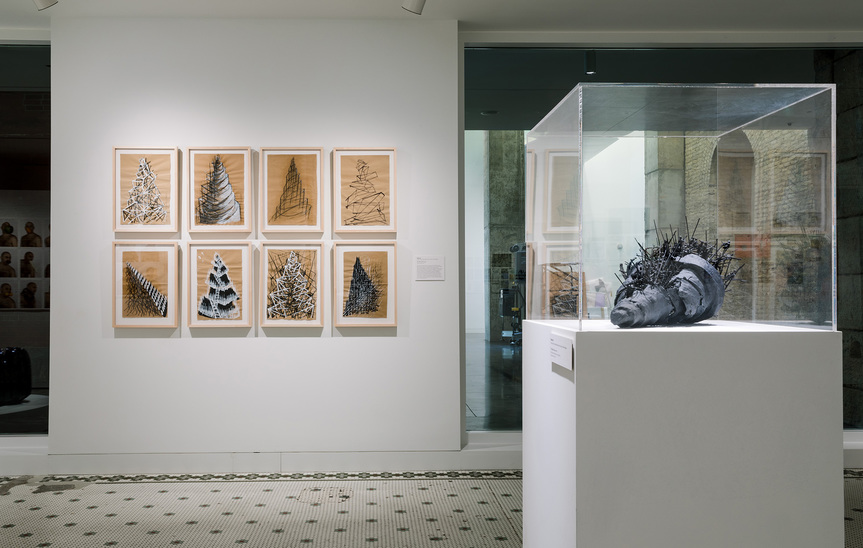-
From Current Issue
-
- Editor’s Letter Fire in the Heart
- Reviews I Gusti Ayu Kadek Murniasih
- Reviews 11th Seoul Mediacity Biennale: “One Escape at a Time”
- Dispatch Networked China
- One on One Monira Al Qadiri on Yukio Mishima
- Essays The rise of independent art spaces in pandemic-era Shanghai
- Features Tuan Andrew Nguyen
- Table of Contents
- Web Exclusives
- Archive
- Subscribe

R
E
V N
E
X
T
Installation view of “History is Not Here: Art and the Arab Imaginary,” at Minnesota Museum of American Art, 2019. All photos by Amanda Hankerson. All images courtesy the artists and Minnesota Museum of American Art.
In the winter 2017 issue of Mizna, an art and literary publication devoted to the Arab diaspora, artists Basel Abbas and Ruanne Abou-Rahme wrote about their visual contribution to the magazine’s pages: “The work(s) begin to splice together a counter-mythology that holds onto our imaginative space as the last terrain to be occupied.” In line with this sentiment, “History Is Not Here: Art and the Arab Imaginary”—presented at the Minnesota Museum of American Art in collaboration with the cultural platform Mizna—rejected the familiar impulse to historicize the Arab world, instead giving agency to individual practices that highlight the multivalent perspectives informing its cultural consciousness today. Organized on the occasion of the 20th anniversary of Mizna’s journal, the show’s curators, Heba Y. Amin and Maymanah Farhat, brought together the works of 17 artists who have filled its pages.
Most artists contributed a single artwork; some, two. As a result, the exhibition served as a concise introduction to a group of contemporary practitioners whose projects touch on topics as varied as the loss of historical memory across generations—as in Zineb Sedira’s three-channel video Mother Tongue (2002), featuring conversations with her mother and daughter—to the hopelessly, and humorously, conspicuous process of foreign acculturation, seen in Raed Yassin’s photographic series Self-Portraits with Foreign Fruits and Vegetables (2009–11). Basel Abbas and Ruanne Abou-Rahme’s multimedia installation And yet my mask is powerful (Fragments 1-3)(2016)—part of a project previously featured in Mizna—takes as its starting point a group of Neolithic masks found in the occupied West Bank that now belong in private Israeli collections. The artists created 3D-printed versions of the artifacts and gave them to Palestinian youths, documenting their field trips to the now-destroyed villages in an act of decolonization and reclamation.
The participating artists spanned a range of ethnicities, ages, genders, viewpoints, and mediums—the discrete bodies of work speaking to the diversity and complexity that were ostensibly the guiding principles of the show. Yet, the exhibition cohered most convincingly around moments of connective dialogue that tied together the different practices on view in poetic ways.
Drawing on Iraq’s ancient architecture, Walid Siti’s eight works on paper from The Tower Series (2016) evoke a range of cultural references, from the spiral tower of the ninth-century Great Mosque of Samarra and the allegorical Tower of Babel to Vladimir Tatlin’s Monument to the Third International (1919–20) and Frank Lloyd Wright’s Guggenheim Museum (1953–59). Through these works on paper and an accompanying model (The Black Tower, 2016), Siti underscores the role architecture plays in projecting the seeming infallibility of state power. Underneath the monolithic facades, however, disruly jumbles of scaffolding hint at the ultimate fragility of such social contracts.
At the other end of the gallery, Ala Younis’s Plan (fem.) for Greater Baghdad (2018) also takes a modernist architectural structure as its subject: the plans for the Saddam Hussein Gymnasium in Baghdad, originally designed by Le Corbusier in the mid-20th century. The multi-part installation of archival materials, drawings, and an architectural model seeks to undermine the official, male-dominated account of the building, and Baghdad’s urban development in general, by foregrounding the female protagonists who were involved in the gymnasium’s realization.
Installation view of ALA YOUNIS’s Plan (fem.) for Greater Baghdad, 2018, two- and three-dimensional prints, drawings, archival and found materials, 3D-printed model, at “History is Not Here: Art and the Arab Imaginary,” Minnesota Museum of American Art, 2019.
Just outside of the exhibition, a selection of books and previous issues of Mizna provided ample reading material—well worth the time for those looking to understand the interplay between the journal’s pages and the physical space of the gallery. In addition to bringing works by an international roster of artists to the Twin Cities, “History Is Not Here”affirmed the important role that Mizna, the only publication of its kind in the United States, has played in contemporary discourse related to art and literature of the Arab and Arab-American diaspora.
“History Is Not Here: Art and the Arab Imaginary” is on view at the Minnesota Museum of American Art, St. Paul, until January 5, 2020.
To read more of ArtAsiaPacific’s articles, visit our Digital Library.











